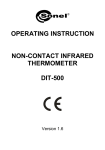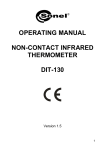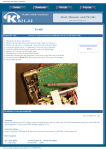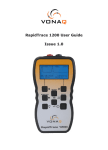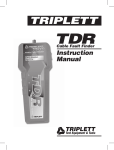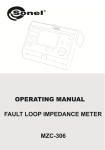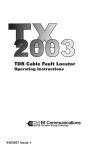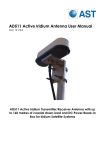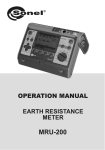Download User Manuals
Transcript
OPERATING MANUAL TDR-410 TDR CABLE FAULT LOCATOR SONEL S. A. Wokulskiego 11 58-100 Świdnica Poland Version 1.01 05.03.2014 TDR-410 OPERATING MANUAL version 1.01 1 We appreciate your having purchased our measuring instrument. TDR-410 is a modern measuring device, which is easy and safe to use. Please acquaint yourself with the present manual in order to avoid measuring errors and prevent possible problems related to operation of the meter. 2 TDR-410 OPERATING MANUAL version 1.01 TABLE OF CONTENTS 1 INTRODUCTION ....................................................................................................5 2 WORKING PRINCIPLES ......................................................................................6 3 PREPARING THE TDR-410 FOR USE ................................................................6 3.1 3.2 3.3 3.4 3.5 3.6 4 SET UNIT OF MEASURE FROM MENU DISPLAY..........................................................7 SET AUTO SHUTDOWN FROM MENU DISPLAY ...........................................................7 SET CONTRAST FROM MENU DISPLAY ......................................................................8 BACKLIGHT............................................................................................................8 SET VELOCITY OF PROPAGATION FROM MENU DISPLAY ...........................................8 HOW TO DETERMINE VP SETTINGS ..........................................................................8 USING THE TDR-410 .............................................................................................9 4.1 SETTING THE FAULT LOCATION ...............................................................................9 4.1.1 Setting Velocity of Propagation (Vp)...........................................................10 4.1.2 Value Impedance Setting (Z) .......................................................................10 4.1.3 Auto Fault Location and Manual Fault Location........................................10 4.1.4 Selecting range scales..................................................................................11 4.1.5 Gain settings ................................................................................................11 5 CONNECTING TDR-410 TO A CABLE TO BE TESTED ...............................11 6 CABLE FAULT LOCATION ...............................................................................12 6.1 6.2 SCAN HOLD AND CONTINUOUS SCANNING MODES ................................................13 ACCURACY...........................................................................................................13 7 TONE GENERATOR ............................................................................................13 8 POWER SUPPLY ..................................................................................................14 9 CLEANING AND MAINTENANCE....................................................................14 10 STORAGE ..............................................................................................................14 11 DISMANTLING AND UTILIZATION................................................................14 12 TYPICAL FAULT DISPLAYS .............................................................................15 13 TYPICAL CABLE VP AND IMPEDANCE VALUES ........................................16 14 TECHNICAL DATA..............................................................................................18 TDR-410 OPERATING MANUAL version 1.01 3 15 ACCESSORIES ..................................................................................................... 19 16 MANUFACTURER............................................................................................... 19 4 TDR-410 OPERATING MANUAL version 1.01 1 Introduction A time-domain reflectometer (TDR) is an electronic instrument used to characterize and locate faults in metallic cables. The TDR-410 is a hand held Time Domain Reflectometer with 11-range-scale covering the range 04000 meters, with a 7 meter first range scale and a 0.5 meter dead zone close and far faults are clearly displayed on its 128x64 pixel back light LiquidCrystalDisplay. The Auto Fault Location key will move the cursor directly to the first event or fault, thus it eliminates the need to interpret visiually the form of wave. When set in manual mode, the wave form may be scanned visually as on conventional TDRs. In both modes the user gains variably coverage of the range of default to 64 db's used to magnify small events identified on the waveform. The scan lock feature will allow the user to hold the trace for closer examination. Designed for identifying and locating faults on all metallic cables with two or more insulated conductors. The TDR-410 has impedance matched circuits for 25, 50, 75 and 100 ohms and with velocity of propagation settings from 1-99% (or the equivalent in feet ormeters/micro second) will cover the range of power, data, communication and CCTV cables. Housed in a rugged IP54 rated ABS enclosure and weighs only 350 grams (12 ounces), theTDR-410 is suitable for outside use. NOTE! Only standard and additional accessories for a given device should be used, as listed in the "Equipment" section. Use of different accessories can lead to errors in the test connection and can introduce additional measurement uncertainties. Note: Due to continuous development of the meter’s software, the actual appearance of the display, in case of some of the functions, may slightly differ from the display presented in this operating manual. Warning: This instrument meets the safety requirements of IEC61010-1: 1995 TheTX2003 is designed for use on de-energized circuits only. Connection to line voltages will damage the instrument and could be hazardous to the operator. This instrument is protected against connection to telecom network voltages according to EN61326-1. Safety is the responsibility of the operator TDR-410 OPERATING MANUAL version 1.01 5 2 Working principles TDR-410 measures the time course of the signal (the probe pulse) in a pair from connecting the cable to the cable end or the nearest damage and back. Probe pulses in the cable run at a speed Vp (the speed of propagation), which depends on the electrical parameters of the cable, in particular the material from which the insulation is made. A reflectometer calculates the distance to the disturbance of wave impedance path and displays the cable's diagram showing any impedance discontinuity in the studied area based on Vp values selected by a user and and measured the course time of the pulse. Output via2x4mm safety sockets LCD display Cursor left key / decrease selected value Cursor right key / increase selected value START fault location / scan hold (for MFL) Navigation button Back light on/off Escape / Return Power on / off 3 Preparing the TDR-410 for use Press button 1. 2. 3. to power the tester, the following screen will be displayed: Model. Software version programmed into tester. Battery condition indicator (all black battery, fully charged, as charge decreases symbol changes to white). Battery condition indicator is permanently displayed. To select a menu display, press the left button 6 as indicated on the TDR-410 front panel: TDR-410 OPERATING MANUAL version 1.01 or to select TDR (Trace Display), press the right button as indicated on the TDR-410 front panel: Prior to use the following parameters will need to be set: Vp (velocity of propagation ) – see part 3.5 i 3.6; Z (impedance) – see part 4.1.2; dB (gain) – see part 4.1.5. 3.1 Set Unit of Measure from menu display Press (SET) to move Press or to unit of measure (feet or meters): to scroll between feet and meters. Press ESC to store selected setting in memory. Note: When unit of measure has been selected, this will automatically change the V/2 figure, which will also be displayed in the selected unit of measure. 3.2 Set Auto Shutdown from menu display To preserve battery life the TDR-410 is fitted with an auto shutdown feature. Shutdown time is selectable between disabled 1, 2, 3 and 5 minutes. To change settings press - Disabled, or - 1 minute, or - 2 minutes, or (SET) to move to Shutdown, use TDR-410 OPERATING MANUAL or version 1.01 to select setting: 7 - 3 minutes, then press ESC to store setting to memory. 3.3 Set Contrast from menu display Press (SET) to move to Contrast. Press contrast, then press ESC to store setting to memory. to decrease contrast, press to increase 3.4 Backlight The LCD display is fitted with an electro-luminescent backlight to enable easy viewing under a variety of different lighting conditions. The backlight is switched on and off with the key . Note: When switched on, the backlight will significantly shorten the battery life! 3.5 Set Velocity of Propagation from menu display Velocity of propagation (Vp) may be set as % or speed in micro seconds (µs). The unit of measure, the speed is displayed in (feet or meters), will be determined by the setting selected in section 3.1 Press (SET) to move to displayed unit, press to scroll between ”V/2 m/µs” or ”Vp %Vc”. To change the value of the V/2 (or Vp) factor, go one level down (press SET button indicator points to the "........ m/µs" (or "Vp = ...%"). ) so that the Pressing the cursor or to increase / decrease the value of the Vp. Press ESC to store selected setting to memory. Note: Setting the correct Velocity of Propagation value is also possible from Trace Display. 3.6 How to determine Vp Settings If the TDR-410 is to be used with a cable type for which the Vp is unknown, this must first be determined by the setting selected in section 3.5 1. Take a sample of the cable at least 10m or 30 ft long (as long as possible). 2. Measure the actual length of cable using a rule or tape measure or some other reliable method. 3. Connect the TDR-410 and adjust the Vp setting such that the tester gives a correct reading of the sample length, (refer to section 4.1 Setting cable parameters). 8 TDR-410 OPERATING MANUAL version 1.01 Note: After disconnecting the TDR-410 the current parameter settings are stored, including the recently selected values Vp propagation factor and impedance Z. This feature of the device is particularly advantageous in situations where multiple tests are performed on the same type of cables. 4 Using the TDR-410 Upon completion of the set up procedures in section 3, press ESC to return to start up display and ), or press START. select TDR (pressing the cursor The following screen will be displayed: 1. 2. 3. 4. 5. 6. 7. 8. 9. 10. Vp setting Impedance setting (Z) Manual / Auto Fault Location Range scale Battery condition indicator Scan hold icon User variable gain (by user or auto) Cursor distance reading Cursor Output pulse 4.1 Setting the fault location You can set all the necessary parameters of the cable fault location from Trace Display: • • • • • Velocity of Propagation Impedance value (Z) Auto or Manual location mode (AFL, MFL) Range Scale Gain To set a parameter, press the SET button ( change the value or the option. ). Until the parameter is highlighted, use TDR-410 OPERATING MANUAL version 1.01 or to 9 Press ESC to store selected setting to the memory of the device. Note: Current parameter settings are stored after disconnecting the TDR-410 4.1.1 Setting Velocity of Propagation (Vp) Use SET button ( values. ) to scroll to “Vp=...%”, when parameter is highlighted, use or to change Press SET button ( ) to move to next parameter, when set up is completed press ESC to store settings. If Vp cable is unknown, refer to section 3.6. TDR-410 will display the values last used after the start up. 4.1.2 Value Impedance Setting (Z) Use SET button ( values. ) to scroll to “Z=.... Ω”, when parameter is highlighted, use Press SET button ( tings. or to change ) to move to next parameter, when set up is completed press ESC to store set- 4.1.3 Auto Fault Location and Manual Fault Location The TDR-410 may be used in auto or manual fault location modes. Use SET button ( displayed setting (AFL or MFL) use key or ) to scroll to to change setting. Press ESC to store settings. Auto Fault Location. When set in auto fault location (AFL) the TDR-410 will scan the cable run and the cursor will automatically stop at the first event. To start the scan press START key, if the scan stops within the first meter (3 feet) it will identified the connection between the TDR-410 and the cable under test as an event, press the key START to continue the scan. The end of the cable run would normally be identified as an open or short (refer to section 12 for typical fault displays). Small events identified in the cable run may be enlarged by increasing the gain thereby making the fault more obvious (refer to section 4.1.5 Gain Settings). 10 TDR-410 OPERATING MANUAL version 1.01 Manual Fault Location When the manual fault location (MFL) is set, the operator selects the range manually and then he needs to scan the displayed trace, and align the cursor manually to the identified event. Note: – see chapter 6.1 „Scan hold and continuous scan mode”. 4.1.4 Selecting range scales The TDR-410 has 11 range scales covering the range of 0 to 4,000 meters (7m, 15m, 30m, 60m, 120m, 250m, 500m, 1000m, 2000m, 3000m and 4000m). To select a range scale, or scan the cable run, press SET button ( ) to scroll to range scale, then press to increase range. To save and exit press ESC. to decrease range or press Note: Manual measurement range change is just for MFL mode. 4.1.5 Gain settings The TDR-410 has pre set gain for each of its 11 range scales, there is in addition to this a user controllable gain to a maximum of 64 dB in 1 dB steps. To use this function, use navigation key (SET ) to scroll to dB setting, press to decrease gain, ting. Note: The "Def" means the default settings. to increase gain, press ESC to store set- 5 Connecting TDR-410 to a cable to be tested Attach the test lead set to the TDR-410 via the 2 safety sockets located at the top of the unit. 1. Ensure that no power supply or equipment is attached to the cable to be tested 2. Ensure that the far end of the cable under test is open or shorted (not fittedwith a resistive termination) 3. Attach theTDR-410 to one end of the cable to be tested TDR-410 OPERATING MANUAL version 1.01 11 Coaxial Cable: Connect the red clip to the centre wire and the black clip to the shield/screen. Shielded Cable: Connect the red clip to a wire adjacent to the shield and the black clip to the shield. Twisted Pair: Separate out one pair and connect the red and black clips to the two wires of the pair. MulticoreCable: Connect the clips to any two wires. 6 Cable Fault Location Having followed the set up procedures in the preceding sections, a typical display showing impedance anomalies is shown below. Further examples are shown in section 12. The vertical cursor line is moved left or right along the line of the trace by pressing or buttons to determine the distance to the event. Position the cursor at the beginning of the event and read off the distance at the bottom left corner. 12 TDR-410 OPERATING MANUAL version 1.01 Example: On the fault display shown above a low impedance fault occurs at 64 meters shown by a negative spike, and a high impedance at 129 meters. The open end of the cable is shown as a large positive spike, this is used to determine the end of the cable run and the overall length of the cable being 180 meters. 6.1 Scan hold and Continuous Scanning Modes This function only operates in manual fault location mode. When the TDR-410 is first switched on, it is set to “Continuous scan”mode. In this mode the TDR-410 fires pulses into the cable under test thus enabling intermittent faults to be identified. Scan hold allows the user to hold a trace for closer examination and to disconnect from test cable whilst leaving the trace displayed. To select / unselect scan hold, press key START (HOLD) for approximately 1 second then release, scan hold icon is displayed at the bottom right hand corner ( 6.2 ). Accuracy The TDR-410 is able to measure distances to faults and cable lengths to an accuracy of +/- 1%. This measurement accuracy is based on the correct value of Vp being used for the cable under test, and homogeneity of the Vp along the cable length. If the Vp is set incorrectly by the operator, or the Vp varies along the length of the cable, then additional errors will be incurred and the measurement accuracywill be affected. Note: The Vp is less well defined with unshielded multicore cable, including power cable, and is lower when a cable is tightly wound on a drum than when installed. 7 Tone Generator The TDR-410 may also be used as a tone generator to trace and identify cables and wires. The user will need a conventional inductive tone probe within the range 810Hz to 1110Hz. To select tone generator from menu display, press SET to move to TDR. Press to scross between TDR and warble. Press the ESC button to exit.. “Warble Tone” on screen mesage is displayed after pressing ESC and TDR generate the tone. TDR mode is switched back if ESC is pressed once again. TDR-410 OPERATING MANUAL version 1.01 13 Note: The auto off function is disabled in tone generator mode so that the tone can be injected into a cable for extended periods while tracing takes place. 8 Power supply Reflectometer TDR-410 is powered by four 1.5 V AA batteries. Use alkaline batteries to ensure proper functioning of the device,. Low battery is signaled by the appearance of the symbol on the screen of the reflectometer. To replace the batteries: - disconnect the instrument from any cable or network link, - turn the instrument off, - loosen the two black screws and remove the battery compartment cover, - replace the batteries with 4 x 1.5 volt Alkaline batteries, observing the polarities - refit the battery compartment cover and refit the two screws 9 Cleaning and maintenance NOTE! Apply solely the maintenance methods specified by the manufacturer in this manual. The casing of the meter may be cleaned with a soft, damp cloth using all-purpose detergents. Do not use any solvents or cleaning agents which might scratch the casing (powders, pastes, etc.). The electronic system of the meter does not require maintenance. 10 Storage In the case of storage of the device, the following recommendations must be observed: • Disconnect all the test leads from the meter. • Clean the meter and all its accessories thoroughly. • In the case the meter is to be stored for a prolonged period of time, the batteries must be removed from the device. 11 Dismantling and utilization Worn-out electric and electronic equipment should be gathered selectively, i.e. it must not be placed with waste of another kind. 14 TDR-410 OPERATING MANUAL version 1.01 Worn-out electronic equipment should be sent to a collection point in accordance with the law of worn-out electric and electronic equipment. Before the equipment is sent to a collection point, do not dismantle any elements. Observe the local regulations concerning disposal of packages, worn-out batteries and accumulators. 12 Typical Fault Displays The following diagrams show typical fault traces to assist you in the identification of faults using the TDR-410: TDR-410 OPERATING MANUAL version 1.01 15 13 Typical Cable VP and Impedance Values Cable type Insulation type VP Electricity paper saturated with oil Cross-linked Polyethylene paraffin polyethylene PTFE paper polyethylene foam air 0,50 - 0,56 0,52 - 0,58 0,64 0,67 0,71 0,72 - 0,88 0,82 0,94 - 0,98 Phone polyethylene outer diameter 0.912 mm polyethylene outer diameter 0.643 mm polyethylene outer diameter 0,511 mm polyethylene outer diameter 0.404 mm gel, outer diameter 0.912 mm gel, outer diameter 0.643 mm gel, outer diameter 0,511 mm gel, outer diameter 0.404 mm paper outer diameter 0,643 m paper outer diameter 0,511 mm paper outer diameter 0.404 mm 0,69 0,68 0,66 0,65 0,68 0,65 0,64 0,63 0,69 0,68 0,66 CCTV QR PARA III PARA I T, TR TX, TX10 RG6, RG11, RG59 Times Fiber RG-59 Dynafoam 0,88 0,82 0,87 0,89 0,82 0,93 0,90 Data transmission RG58 RG58U UTP 26 Thinnet Ethernet Token Ring Twinaxial Air Twinaxial Thicknet RG58 RG58/U Twisted Pair U/UTP cat. 5e U/UTP cat. 6 0,78 0,76 0,64 0,66 – 0,70 0,77 0,78 0,80 0,71 0,77 0,78 0,66 0,64 – 0,66 0,67 0,67 Note: TDR-410 measures the distance to a fault in a cable or the cable length with an accuracy specified in the technical specifications. The current accuracy of the measurement depends on: - how the the propagation factor VP was determined, - its stability on the whole lenght of the tested cable. 16 TDR-410 OPERATING MANUAL version 1.01 The measurement has an additional fault if: - you set an incorrect value of VP, - this ratio is not constant over the measured distance. Please note that the value of the VP factor is smaller for cable wound on the drum's than cable uncoiled / unwound and installed. Furthermore, it may also change with the cable aging. The above examples of VP factor for different cable types are only an indication for the user to make swift and calculate the measurement with reasonable accuracy The use of VP allows the highest measurement accuracy calculated by the user with a known length of the tested cable section, as described in detail in section 3.6. Typical values of impedance Z Cable type Cat 5 STP Cat 5 UTP Coaxial air Coaxial drive Coaxial PE foam Coaxial full PE Symmetrical PE gel Symmetrical dry PE Symmetrical PTFE Symmetrical PVC Paper 72nF Paper 83nF TDR-410 OPERATING MANUAL Z 100 100 50/75 50/75 50/75 50/75 100 100 100 100 100 100 version 1.01 17 14 Technical data Ranges Meters: 7, 15, 30, 60, 120, 250, 500, 1km, 2km, 3km, 4km Ranges Feet 20, 45, 90, 180, 360, 750, 1500, 3000, 6000, 10000, 14000. Range Selection Manual range control / Auto range Accuracy 1% of selected range* Resolution Approx 1% of range Minimum cable lenght: 4m (14ft) Sensitivity Min 3 pixel return at 4km on 0.6mm Ø, PE, TP Velocity Factor Adjustable from 1% to 99% Output Pulse 5 volts peak to peak into open circuit Output Impedance Selectable 25, 50, 75 & 100 Ω Output Pulse Width 3 ns to 3 µs, Automatic with range Scan Rate 2 scans/second or scan held, pre set for each range scale Tone Generator 810 – 1100Hz Battery Life 30 hours continuous scanning Power Supply 6 volts 4 x 1.5 AA Alkaline cells, on-screen low voltage indicator Power Down Selectable 1, 2, 3, 5 minutes or disabled Back Lit Display 128 x 64 pixel Operating Temp -10º / 50ºC Storage Temp -20º +70° C Dimensions 165 x 90 x 37 mm (6.5 x 3.5 x 1.5 ins) Weight 350 g (12oz) EMC BS/EN 61326-1 Water/Dust Proof IP54 Symbol complies with the current EU directives * Measurement accuracy of <+/- 1% assumes the instrument setting for velocity of propagation (Vp) of the cable under test to be accurately set, homogeneity of the Vp along the cable length, and accurate cursor positioning. 18 TDR-410 OPERATING MANUAL version 1.01 15 Accessories The standard set provided by the manufacturer includes the following components: • Time-domain reflektometer TDR-410 WMGBTDR410 • 0,6 m double-wire lead WAPRZ0X6DZBB, • red crocodile clip WAKRORE20K02, • black crocodile clip WAKROBL20K01, • cover M-2 WAFUTM2, • alkaline batteries 1.5V AA (4 pieces), • user manual. It is possible to additionally purchase from the manufacturer and distributors the following elements, which are not included within the standard accessories: • voltage separator AS-2 WAADAAS2. 16 Manufacturer The manufacturer of the device, which also provides guarantee and post-guarantee service is the following company: SONEL S. A. Wokulskiego 11 58-100 Świdnica POLAND (+48 74) 858 38 60 fax (+48 74) 858 38 09 e-mail: [email protected] Homepage: www.sonel.pl Attention: Service repairs must be realised solely by the manufacturer. Made in UE. TDR-410 OPERATING MANUAL version 1.01 19 NOTES 20 TDR-410 OPERATING MANUAL version 1.01
























